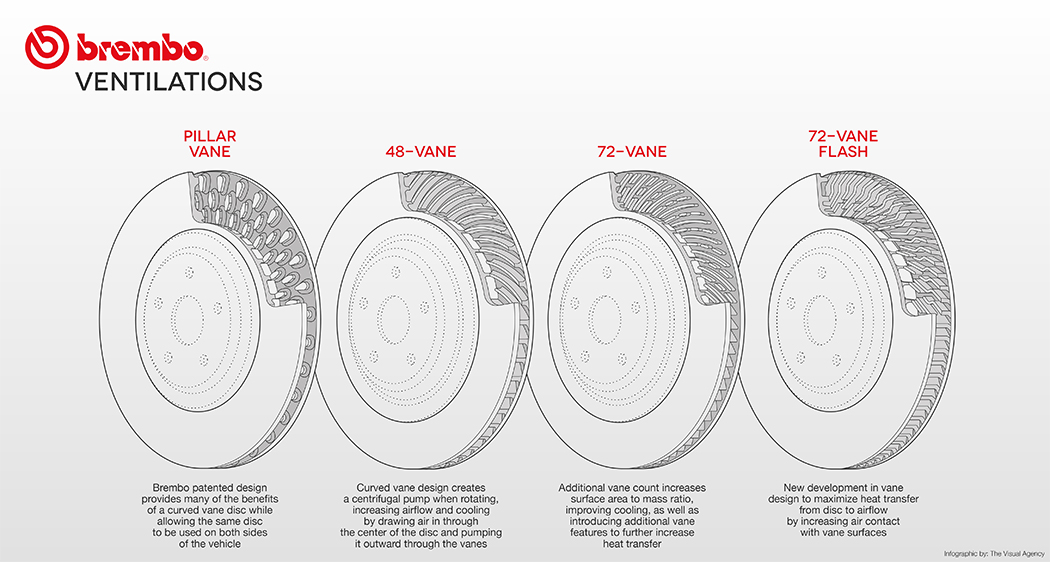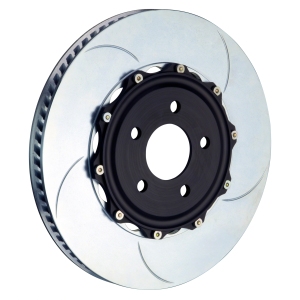Brake Discs | Size Matters
Do different brake discs affect overall braking performance?
-
Material - The material of which the brake disc is cast from; its tensile strength, stability against expansion and contraction, surface hardness and other factors. This is achieved by each manufacturers' own proprietary R&D process where mixtures of additives, carbon content and iron compositions will determine the quality, stability and durability of the finished product.
-
Size - The diameter of the disc determines the brake torque generated by the calipers and pads. Increasing or decreasing the radius will change the brake torque and bias between both axles.
-
Thermal Capacity - Determined by how much weight or mass is located in the outer ring section of the disc. This is the area where the friction surface of the disc meets the internal vanes. The more mass located in this area, the more thermal capacity a disc has.
-
Unsprung Weight - Critically affects chassis dynamics, so a calculated balance between weight reduction and thermal capacity is crucial.
-
Air Gap, Vane Design, Heat Dissipation - This is where two identically sized discs can perform at vastly different levels based on their internal designs, and usually where the differences in manufacturing costs occur. We will look at these design aspects in further detail later.
-
Slot Design - Slot depths, shapes and lengths all influence braking characteristics such as noise, initial bite, modulation, pedal release and pad/disc wear.


Drilled: drilled brake discs are suitable for a wide range of applications, operating temperatures and driving environments (especially wet weather).
- Benefit: offers the highest initial response of all the available disc face types while continuously refreshing the braking surface and being also typically a bit lighter.
- Drawback: Drilled discs are generally more prone to heat checking and thermal cracking if used consistently at extremely high temperatures. This however, really depends on the track, driver, and chassis setup.

Type-1: Brembo “8 straight – slot” face type with an emphasis on stable brake feel and improve resilience against thermal cracking.
- Benefit: stable braking feel at all temperatures, low disc wear, and continuously refreshing the braking surface for optimum performance.
- Drawback: The Type-1 standard disc face has the lowest “initial response” or “bite” compared to Brembo Drilled, Type-3 or Type-5 discs.

Type-3 (Aggressive Face Type): motorsport developed face type with an emphasis on high initial response while maintaining a smooth pedal release.
- Benefit: highest overall braking confidence, control, and allows driver to spend less time on the brake pedal. When chasing the fastest lap time, less time on the brake pedal typically leads to a quicker lap time.
- Drawback: Any disc with an aggressive face type like the Type-3 will have a higher chance to mechanically abrade the pad and disc surface leading to quicker or uneven pad wear. However, this really depends on variables such as car setup or track layout

Type-5 (Endurance Face Type): motorsport developed face type with marginally less initial response compared to the Type-3 face type. The Brembo Racing Type-5 face type was also designed to have lower pad and disc wear for certain long distance endurance races (mostly 10, 12 and 24 hour races).
- Benefit: braking modulation and control similar to Type-3, while offering lower overall pad and disc wear on the track.
- Drawback: While the most well balanced of all Brembo face types, Type-5 discs generally do not have as high of an initial response compared to the Type-3.
